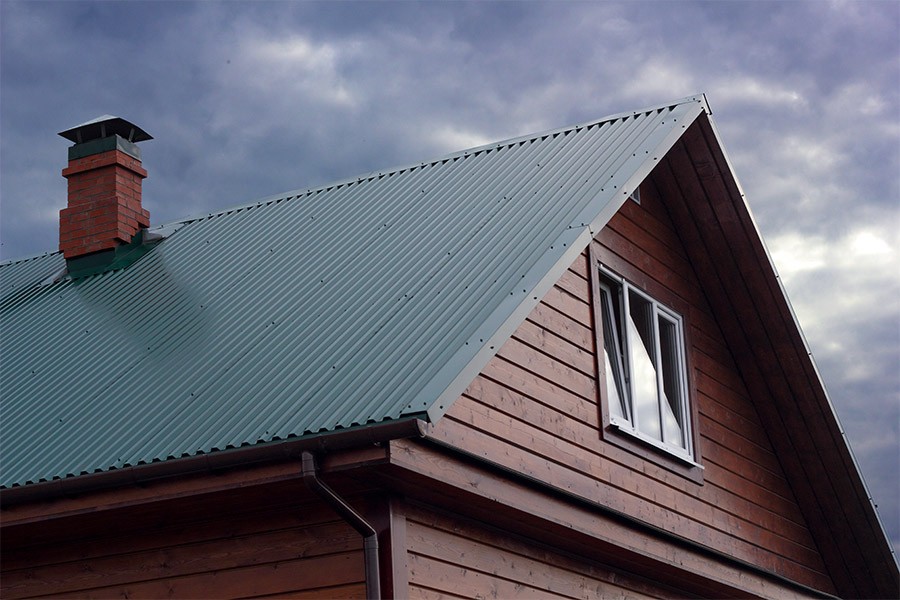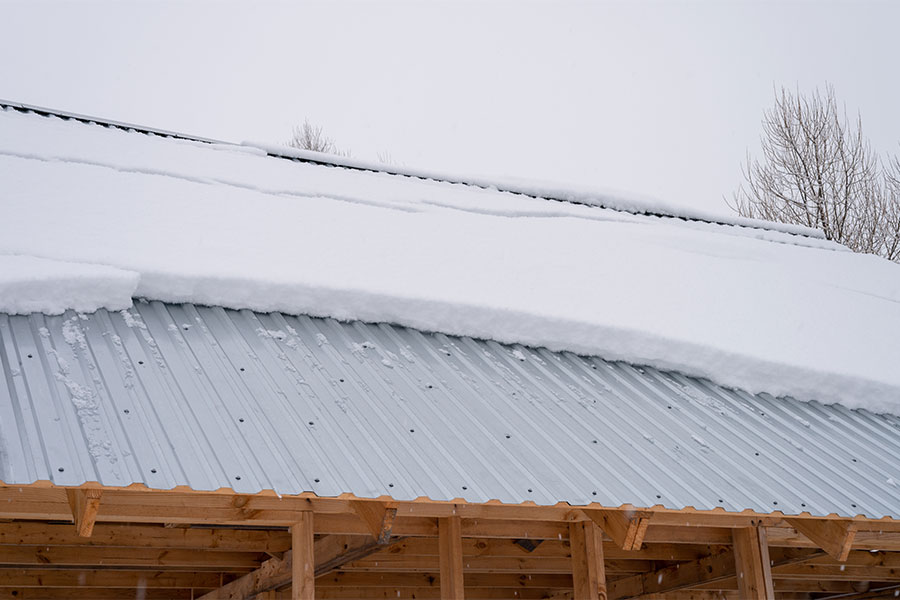We’re no strangers to wind in Montana. Strong summer gusts near Livingston have been clocked at 110 mph or more, and icy gales race through the Rocky Mountain regions all year long.
Given these conditions, you need roofing that can withstand the strongest of winds—and metal roofing is your best choice. Known for their incredible durability, metal roofs are also famous for wind resistance. Most metal panels undergo rigorous testing for wind resistance and repeatedly prove their superiority over shingles or wood shakes. Their ability to withstand the strongest of gusts contributes to their overall roofing performance, keeping your buildings safe, secure, and longstanding.
Whether you’re an architect, contractor, or property owner, understanding metal roof wind resistance can help you make educated decisions for your projects and ensure they stand the test of time (and wind). In this article, we’ll cover the importance of metal roof wind resistance, panel-specific performance, and installation best practices for keeping roofs windproof.
Why Wind Resistance Matters in Roofing
Wind is one of nature’s most destructive forces—especially for roofs. A sudden windstorm can rip shingles or shake wood shake tiles loose, leaving your property exposed to rain and snow. Even in Montana, a place far from hurricanes, high winds can lift a roof off a building if it’s not properly secured. The roof is your first line of defense against the elements, so it needs to resist uplift and pressure.
What Is Metal Roof Wind Resistance?
Metal roof wind resistance refers to how well a metal roofing system can withstand high winds without failing. It’s often expressed as a wind speed rating, such as a metal roof system being rated to handle winds up to a certain miles-per-hour threshold.
So how much wind can a metal roof withstand? Answer: a lot.
Many standard metal roofing systems are engineered to endure gusts around 140 mph or more. For context, that’s equivalent to a Category 4 hurricane wind gust. Some premium metal roofs can even resist winds in the 160+ mph range, far beyond the limits of shingles or wood shakes. Manufacturers test and certify the wind rating for metal roof panels using rigorous uplift tests. These tests simulate suction forces trying to pull the roof up (since high winds create low pressure above the roof and can lift materials).
What Makes Metal Panels So Wind-Resistant?
Metal roofing panels have built-in advantages that make them all-star performers in high winds. First and foremost is their interlocking design. Unlike individual shingles or tiles, metal panels often overlap and interlock with each other on all sides, forming a tight seal like an armor plate. This leaves very few gaps for wind to sneak underneath and pry the roof up. In a windstorm, failure usually starts when air gets under a roofing material and creates uplift. Metal panels’ continuous sheets and secure seams foil that process.
Another big factor is the fastening system. Many metal roofs (especially standing seam systems) use concealed fasteners—clips or screws that are hidden beneath the panels. Because they’re not exposed to the elements, these fasteners are less likely to deteriorate or loosen over time, especially when high winds hit. Even exposed fastener metal panels (which have visible screws) are typically attached with hundreds of screws across the roof, giving a very strong hold.
The material properties of metal also help in its wind resistance. Steel roofing panels have high tensile strength, so they resist tearing or breaking. In a monster windstorm, a metal roof might bend slightly or sustain a dent from flying debris, but it will largely stay intact and keep protecting your home. By contrast, wood shakes can crack, and shingles can shear off or tear. Metal’s durability means even if the wind is strong enough to cause some cosmetic damage, the roof will still be doing its job of sealing out the weather.
Combined, these attributes make metal roofing one of the best roofing materials for high-wind areas you can choose.
Metal Roof Vs Shingles Wind Showdown: Which Wins?
Let’s face it—metal roofs leave shingles in the dust when it comes to wind resistance. While asphalt shingles are common and initially less expensive, they’re vulnerable in strong wind events. Shingles are installed in overlapping rows and held down by adhesive strips and a few nails each—making them prone to lifting and tearing off during high wind pressure. A few missing shingles can expose underlayment or decking, leading to leaks, insulation damage, and expensive repairs.
Metal roofing panels, on the other hand, are secured with dozens (sometimes hundreds) of fasteners and often interlock for added strength. Panels cover larger spans of the roof, creating fewer opportunities for wind to gain access underneath. Because of this, metal roofs are more likely to withstand storm conditions intact. For property owners who want long-term performance, fewer maintenance headaches, and confidence during extreme windstorms, metal panels are the clear winner.
Top 3 Long-Term Payoffs of Metal Roofs
Opting for a wind-resistant metal roof goes beyond surviving the next storm. It’s about the long-term benefits that add up year after year. Here’s the top three benefits of choosing a metal roof for your windy-area project:
- Durability – Metal roofs are incredibly long-lived (often 50+ years with proper care) and they don’t degrade from wind the way other materials do. Where a severe windstorm might strip off half the shingles on a traditional roof (leading to frequent repairs or premature replacement), a metal roof will come through intact, meaning you avoid those emergency repair bills. Over the decades, that reliability saves money and hassle.
- Safety – A roof that stays put in high winds protects your property, the people inside, and even neighboring properties. Flying roof debris in a windstorm can be dangerous and destructive. By having a securely fastened metal roof, you reduce the risk of roofing pieces becoming airborne hazards. Some insurance companies recognize this and may offer discounts for metal roofs because of their superior wind and fire resistance—a nice bonus on top of peace of mind.
- Peace of Mind – Living in a high-wind area, it’s stressful to wonder if your roof will hold. With a properly installed metal roof, you can rest easy when those big gusts blow. You won’t have to constantly check the yard for missing shingles or worry about the next storm—your metal roof has you covered. That peace of mind and security is hard to put a price on.
Choosing the Right Panels for Wind Resistance
To maximize wind resistance, you’ll want to pick a profile and product that is designed for the challenge. Here’s what to consider when choosing panels for a high-wind metal roofing system:
- Concealed vs. Exposed Fasteners: As noted earlier, concealed fastener panels are generally better suited for high-wind zones. Standing seam panels (a type of concealed fastener metal roofing) have no exposed screw holes, meaning less chance of fasteners loosening. Great Northern Metal Company’s concealed fastener roofing systems are specifically wind-tested for extreme weather areas. Exposed fastener panels can still work in windy areas (they often have more points of attachment), but they will require more maintenance over time. If ultimate wind resistance is the goal and budget allows, go with a concealed fastener (standing seam) system for the best performance.
- Panel Profile and Strength: Within the world of metal panels, some profiles handle wind better than others. Look for panels with higher rib profiles or heavy gauge steel if you’re in a severe wind corridor. For example, a standing seam metal roof design might use a mechanically seamed panel These have seams that are crimped shut, making them extremely resistant to being lifted or peeled back. Similarly, narrower panel widths and additional ribs/striation in the flat part of the panel can add rigidity and reduce flutter in high winds. Our team at Great Northern can guide you to the best metal roofing for high-wind areas based on our product lineup.
- Wind Ratings and Certifications: It’s wise to check the wind uplift ratings on any panel you consider. Many metal roofing products will advertise compliance with tests like UL 580 or ASTM wind uplift tests, sometimes expressed as a wind speed (e.g. “rated for 150 mph winds”). While you may not need a hurricane-approved roof in Montana, it doesn’t hurt that metal roofing products often meet those standards. Choosing a panel that exceeds your local code requirements for wind will give you an extra cushion of safety. In high-wind territories, we always recommend erring on the side of a stronger panel – the investment up front will pay off the first time a big wind tries (and fails) to budge your roof.
Installation Best Practices for High Wind Zones
Even the toughest metal panel can underperform if installation is even just a little bit off. Here are some best practices our experts recommend to ensure a metal roof achieves its full wind resistance:
- Secure Fastening Pattern: It’s critical to use the recommended number of fasteners (clips or screws) per panel and to place them as per the manufacturer’s spacing guidelines. High-wind areas often call for tighter screw spacing, especially along edges and corners of the roof where wind pressure is highest. Properly secured fasteners help resist uplift forces by anchoring the panels firmly.
- Use the Right Fasteners: Always use fasteners suited to your roof’s substrate (the material below the panels) as outlined in the installation guidelines. Using the correct length is important too. When in doubt, err on the side of longer fasteners for more bite. If you’re adding snow guards or “snow breaks” on the roof (common in Montana’s snow country), use at least 2-inch screws to mount them. Longer screws ensure those attachments stay put under the force of sliding snow or high winds.
- Exposed Fastener Maintenance: Exposed fastener metal roofs can experience a phenomenon where vibrations (from wind or even regular thermal expansion) gradually loosen the screws. This is sometimes called “harmonic” vibration. The wind can make panels hum ever so slightly, backing out the fasteners over time. The solution is simple: perform an annual check and re-tighten any loose screws. Keeping those fasteners snug will maintain the roof’s full wind uplift resistance.
- Preventing Wind Noise: A well-installed metal roof should not rattle or whine in the wind. To avoid metal roof wind noise, contractors must focus on secure fastening and proper edge details. For instance, adding foam closure strips at the eaves and ridges can block wind from getting under panels and causing a whistle. By ensuring every panel is locked down tight and all trim and flashing are correctly fitted, you’ll have a quiet roof, even on gusty nights.
Ready to Weather the Next Storm? Contact Us for a Consultation
Replacing an old roof? Planning a new build in a windy locale? Let’s talk—Great Northern Metal Company is here to help you make the best choice. Our team has deep expertise in matching high-wind metal roofing solutions to projects across Montana. We can walk you through panel options (exposed vs. standing seam, profiles, coatings) and recommend the ideal setup to keep your roof on tight.
Don’t wait for the next big windstorm to put your roof to the test. Get proactive and fortify your building now. Give us a call or reach out online—our roofing experts are ready to help you hold on tight to a safer, smarter roof.


